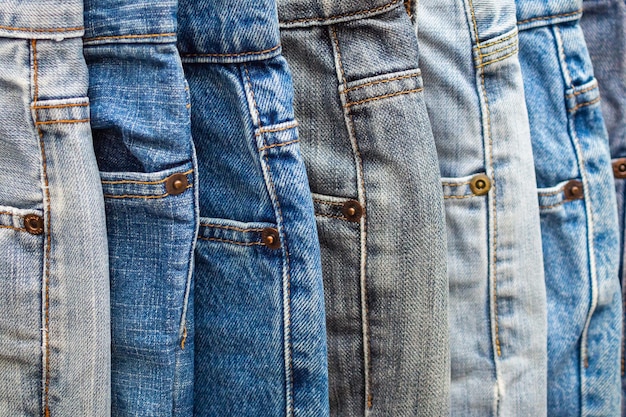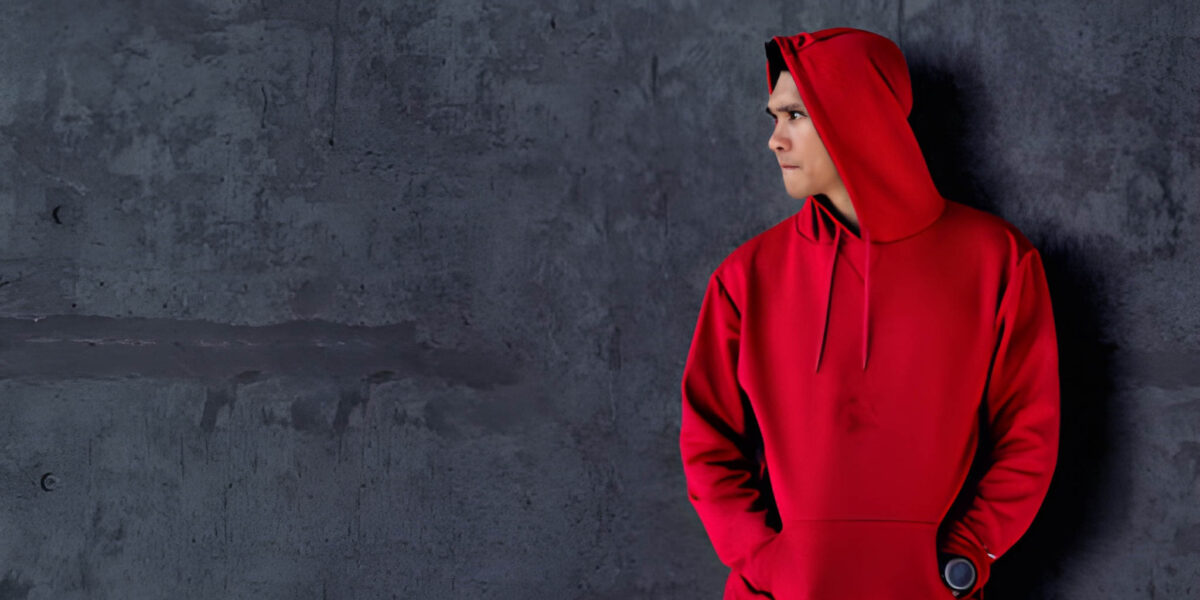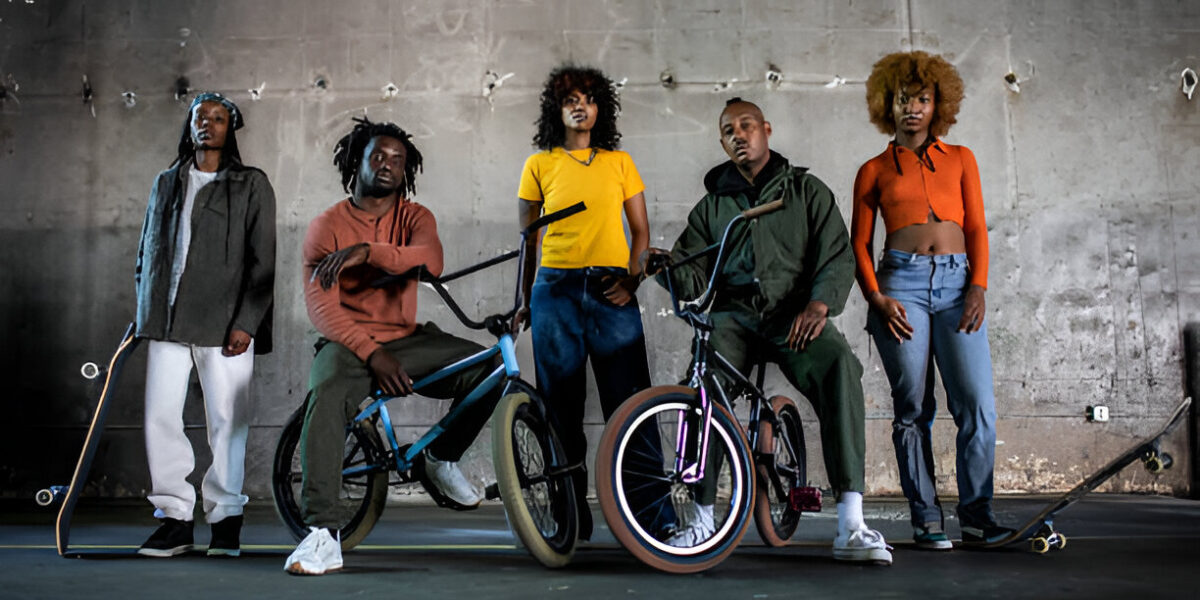Although denim fashions are continuously changing, they are incredibly comfortable to wear for hours, fit bodies perfectly, and are simple to match and pair with other items in your wardrobe, whether for day or night.
However, fashion has changed to include straight legs, wide legs, flares, and more. Based on countless reviews, we’ve compiled the top blue jeans material types with composition and manufacturing below so you can select the ones that will become wardrobe mainstays.
How many types of denim fabric exist? An overview of denim fabric types is provided.
- Dry denim or raw denim
After being dyed during production, raw or dry denim is not cleaned. Raw denim is thus a deep, strong, and tough denim fabric type. Many people prefer the way that such a denim color will fade over time.
- Denim with selvages
One particular style of denim is called selvage. It develops a crisp, unfurling, natural edge. It is constructed with a single cross-yarn in continuous motion, a very sophisticated technique that results in a robust, long-lasting item of apparel. Green, white, brown, yellow, and red thread—the latter of which is most frequently used—are typically used to sew the selvage edge. Comparatively speaking, this style of denim is more expensive. Denim that is either dry or raw
- Denim with color
Warp or weft yarn that has been dyed is used to create brown denim fabric. It’s currently popular. Regular jeans can be given interest, femininity, and a sunny personality by adding colored denim. By using a procedure called piece dying, you can get this kind of denim. In reality, colored denim is twill rather than other denim materials. The fabric that is typically used for jeans and is indigo and white is referred to as “denim,” particularly.
- Poly denim
A dressier kind of denim can be seen in poly denim. Polydenim is for casual clothing manufacturers. It is portable and simple to clean and dry. It is easy to wear and still maintains a polished appearance. This cloth is less likely to wrinkle.
- Bubblegum denim
Lycra-based denim with a 35–50% stretch is known as bubblegum denim. Women’s clothing, like shorts, is frequently made with bubblegum denim.
- Damaged denim

A weft thread with an overtwist is used to weave crushed denim. This denim appears to be wrinkled perpetually. After washing, the fabric shrinks. Bleach and stone can also be used to enhance the appearance.
- Vintage jeans

Old-looking denim is considered vintage. Normal denim that has been stone-washed or given an organic enzyme cellulose wash with bleach has a texture that is tattered and worn-looking.
- Denim bull

a dense weave of thick denim (14 oz. more). Bull denim is strong and heavy, and it takes dye extremely well with excellent results. This denim is ideal for a variety of uses, including headboards, draperies, upholstery, pillow covers, and slipcovers.
- Slubby jeans

Slub denim is defined as denim that has been woven utilizing both warp and weft threads made from slubby, uneven yarn. A more uncommon variety of denim, it fades with a distinctive criss-cross pattern. Denim with crosshatches is another name for it.
- Acid-washed Denim

Scrubbing the fabric with a pumice stone that has been dipped in chlorine produces acid-wash denim. It can also be created by adding chemical acids to the wash. Scrubbed colors deteriorate and take on a mottled, washed, and worn appearance. There have been many instances of this 1980s trend since then.
- Stretch jeans

To give denim fabric some stretch, it can be infused with spandex or lycra. As it is mostly used for tight jeans, this type of denim fabric is a joy to wear because it is so comfortable.
- Ecru Denim

Ecru denim is undyed and is made from cotton that is already that hue. The color is light and creamy.
- Organic Jeans

There are no chemicals utilized in the cotton growth processes of organic denim. This is regarded as a healthier option than conventional denim, much like everything that is organic.
What Is The Fabric Composition Of Jeans?

Fabric for denim or jeans is made of cotton with a durable, tight weave that is occasionally “broken rope” woven into the fabric. The weft yarn is made of carded yarn in the same color as the warp yarn, which is twisted with a dyed chain.
Regarding the fabric’s composition, soft denim fabric, mostly made of cotton and containing 2–3% elastane, is quite popular in modern society. an extremely comfortable fabric that has been expertly crafted to accentuate shapes and suit the body flawlessly, allowing unrestricted movement. The majority of women wear light-stretch jeans, which contain 20.30% elastane as part of the fabric.
Most often used in women’s clothes, light stretch denim is made up of 20.30% elastane. The cotton fiber must first be untangled after being cleansed and agitated. After that, the carding stage is added, which is necessary to separate the fibers and create thick cords that can be pulled and twisted. The fibers enter a centrifuge and are twisted to create a continuous thread, which is then gathered on coils.
The color is applied to the outside of the threads through a bathing and oxidizing process, leaving the inside of the threads their natural white color. Denim fabric for jeans is dyed while still in thread form before weaving. The textiles come to life on the frame, where each thread passes through a ‘liccio’ ring that may be mechanically lifted and lowered. The best fabric jeans are very stiff when they are created, and after the first wash, they tighten by 10 to 12%.
What Is The Most Common Type Of Jeans?

Slim-Fit Jeans
This is one of the most popular and high-quality denim fabric types; it is versatile and can be worn in a variety of settings.
Despite not being as tight as skinny-fit jeans, slim-fit jeans nevertheless suit your legs perfectly. They often have tapering legs, which thin significantly more at the bottom than at the top.
Skinny-Fit Jeans
Denim that fits closely around your legs from top to bottom is known as a skinny fit. Since they are typically composed of stretchable denim, they are cozy to wear. 3–3.5wear.Everyone looks great in skinny jeans.
Straight-Fit Jeans
The most popular types of jeans are straight-fitting. They have a straight leg, which denotes that they are not tapered at the bottom, and are referred to as “regular” because of this.
Men or women who prefer a traditional and timeless appearance can choose straight-fit jeans. You can pair them with numerous kinds of t-shirts, sweatshirts, polos, shirts, jackets, and coats.
Bootcut’s Jeans
The leg opening on bootcut jeans is broader than that on straight-fit jeans. Because they have flared bottoms.
We suggest wearing shirts since these kinds of jeans are perfect for those who want to wear boots. You can create a style to wear on the weekends or for a night out by wearing these jeans.
Loose-Fit Jeans
Jeans that are loose-fitting and comfy are known as loose-fit jeans. Typically, they fit loosely over the thighs and buttocks and feature roomy pockets. When you’re at home or out with friends, we advise wearing them.
Ripped Jeans
Jeans that have been intentionally ripped or damaged are known as ripped jeans. Usually, the knee or thigh area has holes.
When going out at night or on the weekends, for example, ripped jeans are ideal. They look best paired with boots or sneakers.
How Much Fabric Do You Need For Jeans?

Let’s examine the parts required to create a pair of jeans: You need about 1.6 meters of fabric for wide-loom denim. That amount is approximately 2.5 meters for selvage denim (or 3–3.5 meters if selvage is also used for the fly and waistband).
About 1.5 yards of normal denim and 2.0 yards from a short or selvage roll will be needed for each pair of typical jeans. It would be advisable to buy extra denim for any mistakes or errors for the little amount charged per denim yard.
How Are Jeans Made, Step By Step?

To create your pair of homemade jeans, simply follow the step-by-step instructions.
1. Get Your Work Area Ready. In a designated area adjacent to a sewing machine, arrange all of your supplies. To lay out your textiles on the tabletop, make sure you have enough space.
2. Pin The Pattern And Mark It. Lay your denim and cotton fabric flat on your work surface. Then, open the pattern, which should have the shapes for the jean pieces (to be used with the denim) and the front pocket bags (which use cotton). Your pattern’s parts should lay flush when you spread them out across the fabric and secure them with pins.
3. Cut The Pattern Out. Utilizing your jean fabric material cutter, cut the cotton and denim tracings into the desired size.
4. Construct The Front Pockets. To keep the top open, align the front pocket bag pieces at the edges and use your sewing machine to sew the sides together. Sew a denim patch on the pocket bag’s top corner so it can be seen from the front of your pants. Sew the large denim pieces that will make up the front of the legs’ pockets together. The top edges of the pockets should be folded over and ironed to hide any unsewn seams. For a polished appearance, add a top stitch.
5. Make The Pockets On The Back. Fold each edge of the back pocket denim pieces so that no raw fabric is visible. Using an iron, press the pockets onto the large back leg pieces’ fronts. To attach the pockets to the jeans, use a straight stitch.
6. Construct A Fly. Onto the denim piece for the left front leg, stitch straight the fabric piece for the fly. Use the denim-colored thread to blend the seam into the fabric.
7. Finish the zipper. You should fold the unfinished fabric fly edge over the fabric zipper panel on your jeans. A zipper will be sewed onto the interior of each part and used to join the front leg pieces.
8. Stitch The Inseam. Pin the rear leg parts together along the curved edge that runs between the buttocks after stacking the pieces on top of one another. Sew the curved edge of the back of the crotch together using your sewing machine. The front and rear leg components of your jeans should be positioned on top of one another. To attach them, leave a one-quarter-inch seam allowance and pin them together along the inseam.
9. Sew The Sides Together. Invert your pair of jeans so that the inseam is on the outside. Legs’ outer seams, leaving a one-quarter-inch seam allowance, should be pinned together. Utilizing your sewing machine, sew them together. The fronts and backs of the legs are now joined.
10. Hem The Denim. Your jeans’ hems can be finished with a finished seam by folding them twice below to cover the raw edge. Use a straight stitch to sew the hem to hold it in place.
11. Waistband Put On. Sew the waistband pieces together to form a belt shape by stacking the waistband parts on top of one another. Your pants’ tops should be sewn to the waistband.
12. Secure The Belt Loops. From the remaining denim, make little belt loops. Each strip should have a top stitch to conceal the raw edges after being folded over on itself. Five to seven loops are required, depending on the size of your jeans. Your pants’ waistband should have the belt loops stitched along them. The loops’ ends should be riveted shut using the mallet.
13. Fasten The Button And Rivets. Just above the fly of your pants, make a little hole in the waistband. After pulling the end through the hole, bang the button into position using a mallet. Then, on the side of the waistband that is not facing you, create a slit for the buttonhole with your fabric cutter. To strengthen and stop fraying, stitch the hole’s edges. Put rivets in the corners of pockets and belt loops with the mallet.
Related : Start A Denim Line: How To Make Your Mark In The Industry




